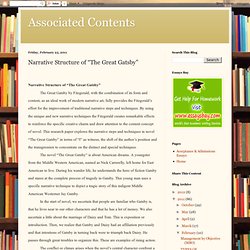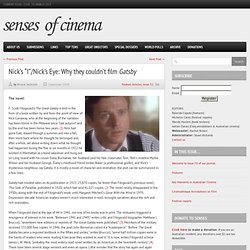

The Use of Modernist Techniques in the Great Gatsby. Fitzgerald used new modern trends in literature with radical, innovative techniques to create a portrait of the decade.

The Great Gatsby was a breakthrough in modernist writing because it was modern day at a time of prohibition and when trends were sweeping the nation. Materialism became the new way of life with for the first time in history the American population centralised within the cities instead of in the country. These changes were lived through by Fitzgerald and were described accurately in the novel. Modernism evolved from a series of movements involving composers, artists, writers (e.g. Stravinsky, Picasso, Woolf, Joyce, Lawrence) and was marked by a rejection of the conventions of the 19th century with an urge to experiment with new forms. The%20Great%20Gatsby. Modernism And The Great Gatsby. The Use of Modernist Techniques in the Great Gatsby. Narrative Structure of “The Great Gatsby” Narrative Structure of “The Great Gatsby” The Great Gatsby by Fitzgerald, with the combination of its form and content, as an ideal work of modern narrative art, fully provides the Fitzgerald’s effort for the improvement of traditional narrative steps and techniques.

By using the unique and new narrative techniques the Fitzgerald creates remarkable effects to reinforce the specific creative charm and draw attention to the content concept of novel. This research paper explores the narrative steps and techniques in novel “The Great Gatsby” in terms of “I” as witness, the shift of the author’s position and the transgression to concentrate on the distinct and special techniques. The novel “The Great Gatsby” is about American dreams. A youngster from the Middle Western American, named as Nick Carrawlly, left home for East American to live. In the start of novel, we ascertain that people are familiar who Gatsby is, that he lives near to our other characters and that he has a lot of money. Narrative Structures in TheGreat Gatsby and Snow Falling on Cedars. Nick’s “I”/Nick’s Eye: Why they couldn’t film Gatsby. The novel F.

Scott Fitzgerald’s The Great Gatsby is told in the form of a book written by and from the point of view of Nick Carraway, who at the beginning of the narration has been home in the Midwest since “last autumn” and by the end has been home two years. (1) Nick had gone East, stayed through a summer and into a fall, then went back where he thought he belonged and, after a while, set about writing down what he thought had happened during the five or six months in 1922 he worked in Manhattan as a bond salesman and hung out on Long Island with his cousin Daisy Buchanan, her husband (and his Yale classmate) Tom, Tom’s mistress Myrtle Wilson and her husband George, Daisy’s childhood friend Jordan Baker (a professional golfer), and Nick’s mysterious neighbour, Jay Gatsby.
It is mostly a novel of character and revelation; the plot can be summarized in a few lines. When Fitzgerald died at the age of 44 in 1941, not one of his books was in print. Film Versions Pages and Screens. The ordering of events in “The Great Gatsby” Introduction In The Great Gatsby Fitzgerald condensed the story’s events.

It appears that two important changes were introduced: Fitzgerald suppressed a long episode of Gatsby’s childhood in order to heighten the sense of mystery surrounding his protagonist’s youth. This fragment was then turned into a short story Absolution that was published in a review Mercury.The second important change concerned the order of the events and the fact that in the original version it was Gatsby who spoke. In the final version, all the action unfolds during one summer – from mid June to early September – and the geographical location is confined to New York, Long Island: East Egg and West Egg. I. The story’s events have apparently been scrambled, but it is in fact the sign of artistic order.
A. There is a network of correspondences and sharp contrast between the prologue and the epilogue. B. II. A. Gatsby may be described as an hour-glass novel; it is built on a principle of symmetry. B. III. A. B.